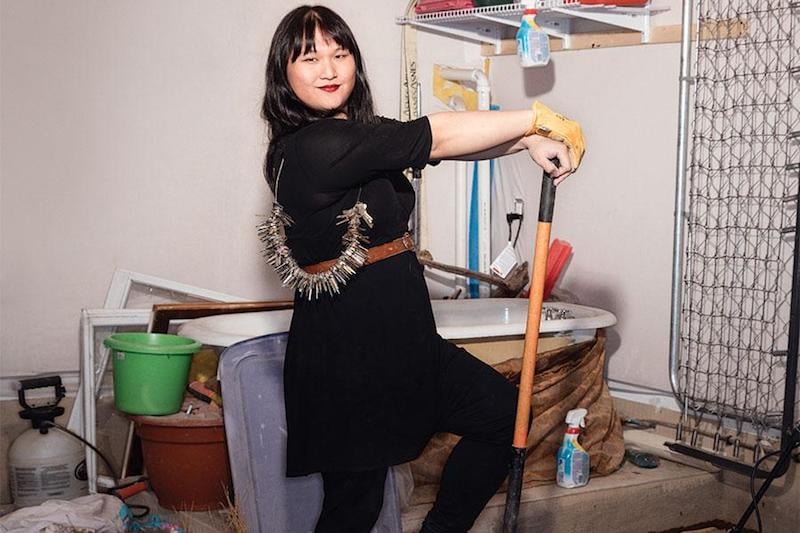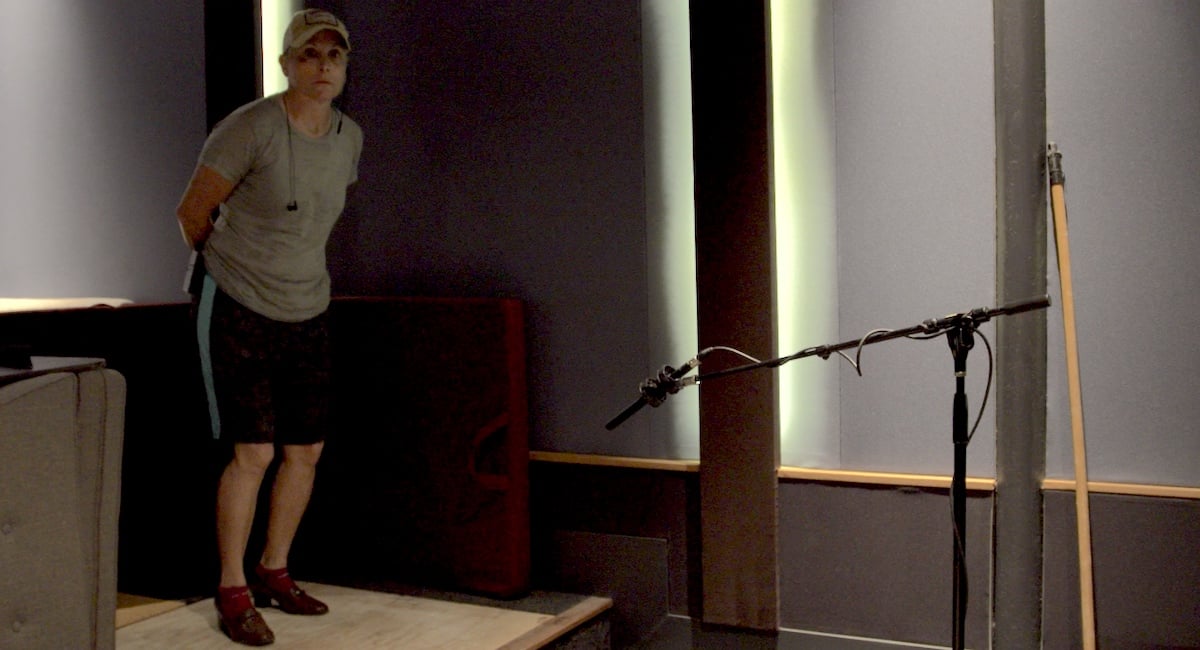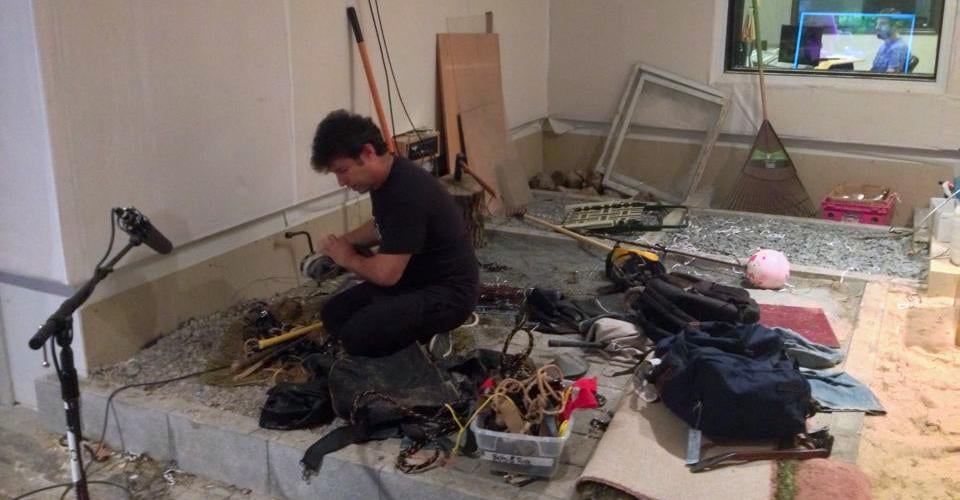Explore one of the most misunderstood aspects of the audio post production process – and what it means in today’s industry.
I’ve eaten an entire grapefruit to “cheat” the sound of a dragon heart. I’ve made bed sheets weep and car crashes moan. I’ve researched the chemical production of meth to craft the perfect sound for drug lab mixing chemicals. I’ve imbued an actor’s performance and emotions into audible and literal sounds all to the cadence of the moving image.
My name is Joanna Fang and I’m a Foley artist. For the past 7 years, I’ve been performing and crafting sound effects in sync to picture. I’m often asked to merge the impressionistic with the ultra real, taking the ordinary and making it sound extraordinary.
This type of painstaking work still exists. Yes, it’s a craft accompanying sound design and sound editing. No, we have not been replaced by computers or libraries, we have not been MIDI’d to death (although brave attempts have been made), and our art is still a necessity in modern digital sound – both narrative and experimental. Over the past 7 years, I’ve performed Foley for films, television, web, virtual reality, interactive art, and gaming. I’ve been an “old timey soundman" and crafted vaudevillian sounds on radio for NPR and on stage. If it needs to be seen, felt, and performed live to an image, I’ve “Foley’d” it.
In the 2000s, independent filmmaking and digital sound culture created a media renaissance. Now that the dust has settled, it’s a good time to take stock of what a Foley artist does – and how Foley as shorthand has evolved to linguistically coexist within the greater umbrella of sound effects in 2019.
In a world of portable digital recorders, vast sound effects libraries, unlocked picture, uncanny CGI, ASMR, and artificial intelligence: What is modern Foley? And why do filmmakers, sound designers, and audiences still hunger for it?
"The language of Foley is a language of textures, emotion, performance, weight and perspective... Foley art is truly art."

A Little History
90 years ago, the film Showboat was released by Universal. Showboat was initially conceived and filmed as a silent film and, like a tale as old as time, studio executives decided last minute to add an expensive and labor intensive soundtrack to the film. (It may also be one of the earliest instances of “fix it in the mix” but don’t quote me on that.) The post production addition of music and sound effects was still a concept in development; even the Vitaphone for direct dialogue recording was very much state of the bleeding art. The agreed upon solution was to hire multiple sound artists to perform sound effects recorded directly to sync with picture, on the same sound stage as the orchestra, and printed onto the same track as the musical score.
It was imperative these sound artists perform every cue precisely to sync with picture, and craft every sound from what we now call background and hard FX (the rolling of thunder, the crackle of fire) to the footsteps and rustle. They did all of this without the aid of punching in, the breadth of multitrack, and the mercy of editorial. Jack Foley was the supervising sound to sync performer on 1928’s Melody of Love and 1929’s Showboat, taking charge of a small crew of artists and leading them through the sound effects accompaniment. He pioneered the art form and eventually the shorthand for his strange prop-and-shoe-filled studio became known as “Foley’s stage.” The sounds themselves became known as “Foley’s” and, although those artists were initially known as “Foley’s walkers,” the phrase evolved over decades into the more appropriate “Foley artists.”
Vanessa Ament’s The Foley Grail dives into the history of Foley art more so than I can ever write in a single blog post for those so inclined. It’s somewhat impossible to trace the lineage of sound effects for film without recognizing the immense talent and breadth of sounds these often uncredited artists performed – especially the man himself, Jack Foley. The history of sound design starts from a performer in a theater stomping their feet in sync whilst looking up to a projected image as an audience looks on immersed. As technology evolved, that Foley artist never really left, since there has always been a demand for those emotionally and vividly evocative sounds.
"Aside from its shorthand use amongst the post production world, 'Foley' as a word has changed as filmmaking and sound design culture have become more global, democratic, and open to the public. This extra bit of awareness has been a blessing and a curse."
Susan Fitz-Simon performing footsteps at Soundcrafter in Austin, TX
Foley Today
In 2019, things are vastly different. Foley artists mostly cover any sort of customizable sound effect that must be performed and imbued with the energy and aesthetic of the moving image. We perform and re-auralize sounds that must be created at the moment of recording and can’t be pulled or edited together with a sound library or field recordings. We also create impressionistic sounds that the audience needs to feel but are non-existent in reality: guns typically don’t rattle, handshakes are usually imperceivable. We craft sounds that are dependent on an understanding of the film’s rhythms and are tightly synced with the emotion and storytelling in a very kinetic way. We depend on life experience to find that middle ground between impressionism and technical accuracy to help immerse the audience into the emotional world of the characters.
For instance, a jogger escaping a serial killer running through concrete, dirt, and leaves needs the consistency in sound, changes of perspective, variety of acoustic performance, and tangible evocative emotion that would have been impossible to capture on set or exceedingly difficult to edit together from library sources. At a moment’s notice, a highly trained Foley team can evoke the fearful scampering of a mouse to the glorious gallops of an elephant all to sync. We also personify and give life to something as benign as paper being shuffled with the menace of an evil accountant.
The language of Foley is a language of textures, emotion, performance, weight and perspective; rarely is it pure crime lab levels of forensic realism. Foley art is truly art. However, evolutions in workflow, film sound language, and a more global workforce have created a linguistic and aesthetic anomaly. Somehow, the word “Foley” has become grammatically similar to the other “F” word and in doing so, we’ve lost some hard drawn lines in our film sound lexicon.
Evolution or Confusion
Both the “F” word and “Foley” have uses as transitive and intransitive verbs, proper nouns, common nouns, gerunds, and adjectives. I’ve “Foley’d” films, I've performed “Foley”, I've asked for a “Foley” here and there. For goodness sake, I’ve even “Foley’d” myself once for a branded content documentary about “Foleying.” The evolution of the word “Foley” from one man’s family name to this powerful, all-encompassing modern word is based on several things.
Aside from its shorthand use amongst the post production world, “Foley” as a word has changed as filmmaking and sound design culture have become more global, democratic, and open to the public. This extra bit of awareness has been a blessing and a curse. I have heard the word used erroneously to describe the entire film sound effects track. I’ve heard game audio designers and digital microphone manufacturers at AES accidentally mix up “Foley” with “foliage” leading to many hysterical conversations about recording trees and very confused engineers. I’m especially annoyed when journalists call Foley “ambient or background sound,” since there are literally editors whose entire art is to craft together ambiences and backgrounds. Often, Foley sounds are featured prominently or as storytelling elements; I wouldn’t call the Foley of hypnotic teacup stirring in Jordan Peele’s Get Out as “background or ambient sound.”
This “Foley Babel” is a symptom of our information age. There is an obsession with filmcraft and a blurring of lines between those who consume and those who produce media. More people are aware of Foley through featurettes, YouTube videos, and documentaries; all to mixed degrees of comprehension.
So What Is It?
“Foley” is more than just a craft, an art with its own philosophies, or a genre of sound effects. To me, the word Foley describes the performance to picture of custom sound effects that are the creation of a highly specialized team of sound craftspeople. A Foley artist performs the sound, the Foley mixer provides real-time moving perspective while directing the artist, and the Foley editor chooses what to shoot and finesses the sync to picture.
With that in mind, can there be “Foley art” without a film? Is “wild Foley” or a “Foley sound effects library” misnomers if these sounds weren’t recorded or crafted to accompany a very particular performance to sync? The lines are blurred even more when my team works on bigger budget films where the overlap between Foley and hard FX/sound design becomes a collaborative pairing for every single punch, throw, and bodyfall. The overlap between field recording and Foley becomes blurred when we take our Pro Tools rigs mobile and perform the footsteps in real locations. Is it Foley if I memorized the shot, went home, recorded the routine, and brought it back to the Foley editor?
This all leads to the elephant in the room. Hold for tone.
Foley… Effects?
Here I am on the Pro Sound Effects Blog for the release of their new Foley Effects sound library from the Odyssey Collection. And while I'm more than happy to see these recordings available to sound designers, I want to remind folks that, although we may use the words “Foley effects” as a shorthand to describe the genre of the everyday sound of props and footsteps, we still need to acknowledge that Foley art is all about the performances and personifications whose sounds go far beyond literal recordings of props and feet. Anyone can record themselves walking down a set of interesting stairs, anyone can “borrow” their girlfriend’s purse and record a million different variations of zippers.
I highly encourage any form of creative recording and designing sounds unique and personal at whatever costs. However, even within teams with access to rich and dynamic sound libraries, there still exists this need for performative dramatic human sounds, and there still exists this necessity to have a Foley artist perform those sounds to perfection – Foley mixed right in the pocket, and edited dead onto sync. If someone wanted to clinically and painstakingly cover and edit together the prop and feet sounds from library sources, the technology exists. However, these are the sounds that Foley teams would inevitably record, and the combined brushstrokes of those performances can paint a scene far more vividly than an effect washed in EQ and reverb, stitched up and morphed vaguely to sync.
I’ve seen low budget films where the feet are performed via MIDI randomization; I’ve heard props get edited in from libraries; I've watched self-learning AIs teach itself to pair audio to video without overheating the computer. I do not deny technology and I’ve heard my work accompanied beautifully with a powerful library source or field recorded sound effect. I do not deny the financial reality that hiring a Foley team is fairly expensive to the microbudget independent feature or a student film. I’ve been told to only prioritize story driven elements, especially when time is excruciatingly limited on the Foley stage, or if the film doesn’t aesthetically call for every single hand movement to be covered by that human effort.
"A rich collaboration among hard FX, library FX, field recordings and Foley art drives home the emotional, textural, and performative sounds of stories. A good sound team has the grit to just get those perfect sounds for each and every scene."
All in the Service of Story
Stepping back, there’s a reason why a good deal of my clients are both happy users, endorsers and even employees of Pro Sound Effects as well as my home Foley stage Alchemy Post Sound. A rich collaboration among hard FX, library FX, field recordings and Foley art drives home the emotional, textural, and performative sounds of stories. A good sound team has the grit to just get those perfect sounds for each and every scene. A fight scene may be cut together with excellent punches recorded over a decade of field recordings, the dialogue scrubbed clean, the ADR grunting all in harmony with one another. Having a Foley artist run through the same fight scene to provide consistent texture and a musical performance of clothing and hits can augment the existing orchestration of sound with a unifying performance. I acknowledge that sometimes all a cue needs is something from a library and I also acknowledge time and situations where the Foley team can only hit story important moments. Great sounding films are not a product of a Us vs. Them mentality.
All of this human effort is to get the right sound, and there’s such a variety of tools available today. The coexistence of the Foley team and the handy effects library has been around for a while, and the craft has given filmmakers more tools and opportunities to tell their stories across a variety of budgets and circumstances. Blessed be thy sound editors, they giveth me more time to focus on story driven sounds and difficult Foley performances.
Leslie Bloom at Alchemy Post Sound
I grew up in a culture of rapidly changing technology and automation, yet I’m not afraid for the future of Foley art and soundcraft – I’m not afraid of libraries, MIDI, or artificial intelligence (see FoleyBot video below...). Foley art is more likely to be eroded by shrinking production budgets and changes in audience’s aural taste rather than by the technology and breadth of library sounds and tools. Sound for film has been on a wild ride with new generations of sound artists rewriting the rulebook and challenging decades old dogmas, However, why reinvent the wheel if that wheel can perform nearly 400 footstep cues across several characters on dozens of surfaces, rooms and shoes all in a single day’s worth of work? And conversely, why do Foley artists become so defensive in the face of new technology or a library effect when the mix is at the 11th hour on an overnight with layback happening the next day?
Necessity is the mother of invention, and I'm lucky to be coming up in the generation where we have the time honored traditions of Foley artists paired with the high quality and wide breadth libraries of the 21st century. Truly understanding what great Foley artistry can do for a film, is to understand that its very performative nature will likely keep it around for as long as we make moving images.
 Joanna Fang is an Emmy-winning Foley artist at Alchemy Post Sound. She has performed Foley for over 200 films, documentaries, television shows, live theater, and experimental media.
Joanna Fang is an Emmy-winning Foley artist at Alchemy Post Sound. She has performed Foley for over 200 films, documentaries, television shows, live theater, and experimental media.
Follow Joanna: IMDb | Facebook | LinkedIn













